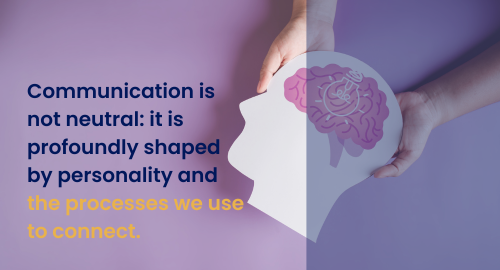
The world of Process Communication Model® (PCM) has just reached an exciting new milestone. A groundbreaking study by Sixtine Lefebvre, published in Cognition and Emotion, an international peer-reviewed scientific journal, in 2025, provides the first physiological evidence that our emotional reactions during communication depend on both the way we are addressed and our PCM Base Type.
This research opens new horizons for PCM, confirming what many practitioners observe every day: communication is not neutral: it is profoundly shaped by personality and the processes we use to connect.
The Research Behind the Breakthrough
Carried out at Université de Rouen Normandie, the study involved 90 participants who were invited to respond to different communication prompts. Some prompts asked them to share facts or opinions, while others aimed to spark intimacy, imagination, or action. While participants engaged in these exchanges, researchers measured their skin conductance response, a classic indicator of emotional activation.
Key Findings
The results were striking:
• Different PCM Processes triggered distinct emotional responses.
• Creating intimacy (NCE) and complicity (ECR) generated the highest emotional impact.
• Asking for opinions (RCO) also created stronger emotional arousal than simply exchanging data (RCT).
• Most fascinatingly, Persister Base participants stood out: their emotional responses followed a unique pattern, consistently different from other Base Types.
In plain words: how we speak, whether we ask for opinions, share emotions, or invite reflection, changes the listener’s emotional response, and this effect is amplified by their PCM Base Type.
Sixtine Lefebvre: A Path of Passion and Rigor

Behind this achievement is the dedication of Sixtine Lefebvre, a researcher with Kahler Communication France and Université de Rouen. Sixtine has been steadily building a bridge between academic science and the PCM community. Previous studies already explored how PCM Base Types influence attention and creativity; this new publication extends the evidence into the field of emotions, one of the most vital aspects of communication.
Her work demonstrates that PCM is not only a practical tool used worldwide in coaching, leadership, healthcare, and education: it is also a scientifically validated model that continues to grow in credibility. By showing that PCM predictions can be observed at the physiological level, Sixtine has provided a landmark validation for PCM practitioners and researchers alike.
What This Means for PCM
This study highlights something PCM trainers and coaches often emphasize: effective communication is not “one-size-fits-all.” Instead, it requires adapting our approach to the personality structure of the person we’re speaking with.
Key Takeaways for the PCM Community and Beyond
• PCM is measurable: It’s not only a coaching model but also a framework that can be tested in labs and validated scientifically.
• Personality drives emotional resonance: Each Base Type has unique sensitivities that shape how messages land emotionally.
• Better understanding fosters tolerance: By recognizing these differences, we strengthen empathy, respect, and relational agility.
Why It’s Outstanding
For the first time, PCM has been linked with hard data on physiological emotional responses, through rigorous scientific experimentation. This means that what trainers and coaches observe in practice is now supported by robust scientific findings. The research doesn’t just confirm PCM’s validity: it elevates it, placing it in the conversation alongside leading theories of emotion and communication science.
As Dr. Taibi Kahler envisioned, PCM continues to evolve as both a practical tool and a subject of scientific exploration. Thanks to researchers like Sixtine Lefebvre, we can now say with even more confidence: PCM works, and science proves it.
Looking Ahead
This study is not the end but the beginning of a new chapter. By opening the door to experimental validation, it paves the way for more research on how Process Communication Model influences not only communication but also emotional well-being, resilience, and performance in different fields.
Learn more about
PCM Holiday Stress Strategies for Family Gatherings
Date: November 24, 2025
PCM and Competition: Why This Model Stands Apart
Date: November 4, 2025
PCM and Breast Cancer Awareness: A Story of Renewal
Date: October 9, 2025
PCM and Impostor Syndrome: Break the Cycle of Self-Doubt
Date: October 8, 2025
PCM Training Industry Partnership: A Game-Changer
Date: September 22, 2025
Pixar Process Communication Model: Storytelling Secrets
Date: September 16, 2025


